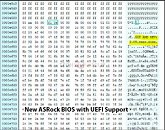Monday, February 11th 2019

AMD Radeon VII Has No UEFI Support
In what is turning out to be a massive QA oversight by AMD, people who bought retail Radeon VII graphics cards report that their cards don't support UEFI, and that installing the card in their machines causes their motherboard to engage CSM (compatibility support module), a key component of UEFI firmware that's needed to boot the machine with UEFI-unaware hardware (such as old storage devices, graphics cards, NICs, etc.,).
To verify this claim, we put the stock video BIOS of our Radeon VII sample in a hex editor, and what we found out startled us. The BIOS completely lacks UEFI support, including a GOP (graphics output protocol) driver. A GOP driver is a wafer-thin display driver that runs basic display functions on your GPU during the pre-boot environment. Without UEFI support for the graphics card (i.e. with CSM running), Windows 10 cannot engage Secure Boot. Since UEFI Secure Boot is a requirement for Microsoft Windows 10 Logo certification, we are having doubts whether AMD can really claim "Windows 10 compatible" for Radeon VII, at least until a BIOS update is available.ASRock is the first AMD AIB (add-in board partner) to release a corrective BIOS update. Although designed for its Radeon VII Phantom Gaming graphics card, this BIOS ROM works with any reference-design Radeon VII graphics card. All Radeon VII cards are identical, so flashing the ASRock BIOS onto a Radeon VII from AMD or any other board partner will not cause any issues.
Parsing the ASRock BIOS ROM file through a hex editor lets us see telltale signs of UEFI support, including the GOP micro-driver. Please pay attention to the highlighted UEFI-magic, which, when read in Intel byte-order, becomes "0EF1" aka "UEFI" in leetspeak. This magic sequence of bytes tells the rest of the system that the BIOS on this specific device reports that it supports the UEFI standard.
It is highly likely that most, if not all, Radeon VII graphics cards shipped so far lack UEFI support, and in the coming days, all AIB partners could come up with BIOS updates. Trouble is, updating video BIOS isn't anywhere near as easy as updating motherboard BIOS, and not everyone is skilled or confident enough to tinker with it. One option AMD could try is an encapsulated one-click BIOS updater that can run from within Windows.
Last year, NVIDIA corrected widespread DisplayPort issues in its "Pascal" graphics cards using such an approach. Until something like that happens, you can grab the updated Radeon VII Phantom Gaming video BIOS from the TechPowerUp VGA BIOS Database, linked below. The ATI/AMD BIOS flashing software can also be found in our downloads section.
DOWNLOAD: ASRock Radeon VII Phantom Gaming BIOS Update with UEFI Support
Update Feb 12: AMD has confirmed that they will release a one-click BIOS updater on AMD.com very soon, and that their board partners have received a UEFI capable BIOS.
Source:
Discovery Thread on our Forums
To verify this claim, we put the stock video BIOS of our Radeon VII sample in a hex editor, and what we found out startled us. The BIOS completely lacks UEFI support, including a GOP (graphics output protocol) driver. A GOP driver is a wafer-thin display driver that runs basic display functions on your GPU during the pre-boot environment. Without UEFI support for the graphics card (i.e. with CSM running), Windows 10 cannot engage Secure Boot. Since UEFI Secure Boot is a requirement for Microsoft Windows 10 Logo certification, we are having doubts whether AMD can really claim "Windows 10 compatible" for Radeon VII, at least until a BIOS update is available.ASRock is the first AMD AIB (add-in board partner) to release a corrective BIOS update. Although designed for its Radeon VII Phantom Gaming graphics card, this BIOS ROM works with any reference-design Radeon VII graphics card. All Radeon VII cards are identical, so flashing the ASRock BIOS onto a Radeon VII from AMD or any other board partner will not cause any issues.
Parsing the ASRock BIOS ROM file through a hex editor lets us see telltale signs of UEFI support, including the GOP micro-driver. Please pay attention to the highlighted UEFI-magic, which, when read in Intel byte-order, becomes "0EF1" aka "UEFI" in leetspeak. This magic sequence of bytes tells the rest of the system that the BIOS on this specific device reports that it supports the UEFI standard.
It is highly likely that most, if not all, Radeon VII graphics cards shipped so far lack UEFI support, and in the coming days, all AIB partners could come up with BIOS updates. Trouble is, updating video BIOS isn't anywhere near as easy as updating motherboard BIOS, and not everyone is skilled or confident enough to tinker with it. One option AMD could try is an encapsulated one-click BIOS updater that can run from within Windows.
Last year, NVIDIA corrected widespread DisplayPort issues in its "Pascal" graphics cards using such an approach. Until something like that happens, you can grab the updated Radeon VII Phantom Gaming video BIOS from the TechPowerUp VGA BIOS Database, linked below. The ATI/AMD BIOS flashing software can also be found in our downloads section.
DOWNLOAD: ASRock Radeon VII Phantom Gaming BIOS Update with UEFI Support
Update Feb 12: AMD has confirmed that they will release a one-click BIOS updater on AMD.com very soon, and that their board partners have received a UEFI capable BIOS.


81 Comments on AMD Radeon VII Has No UEFI Support
It's so easy to forget something important when things are rushed. I've learned that the hard way…
BTW, have you reached out to other reviewers if they can confirm the same problem?
A UEFI updater tool that can add the latest AMD GOP version(2.5.0.0.0 which can both be downloaded here) also already exists. I just can't confirm it works(as in results in a BIOS that will boot) with the Radeon VII BIOS(as I don't own a Radeon VII). You still need to know exactly what you're doing with the tool. But I've already done it twice now for the Radeon VII BIOS(with 2 different AMD GOP versions). Which is a walk in the park for me. Since I've been doing the same with other AMD BIOSes for quite a while now.
It's no accident that cards usually go through a round of external QA before launch, to catch such obvious problems.
I guess it's kind of fortunate that only a few hundred(?) cards have been shipped so far.
As with all such problems, it's always cheaper in terms of actual cost and PR to deal with it immediately instead of deflecting and denying. Dealing with it properly builds customer confidence, but it's when companies fails to do so they are risking lawsuits.
Full product recall? JFC! You can't be serious. This is solvable by a BIOS update for Christ's sake. And the card will still work fine in the mean time without it. You're blowing this WAY out of proportion.
trog
Chill out people. This is not a catastrophe!
I will give AMD the benefit of the doubt and assume this was simply due to it being so early on the first wave of cards and it will be addressed very shortly. But it's amazing that the card would get this far with that significant of an issue in place, and it raises questions to me about the VII being rushed and what other issues we'll come across. So if I were in the market for one I think I'd have to lean towards skipping the launch day cards. That's a lesson I'd say applies to both AMD and NVidia. EVGA had VRAM overheating issues with their launch NV 1080ti's. It's kind of the same reason they say to not buy the first year of a new car model, since it always takes them about a year to work the issues out.
PowerColor and I believe Sapphire are pretty good about updates as long as you are totally honest and give all info from the card that is requested.There have been times MS has asked people to disable that function due to OS problems...
Talk about card bricking